June 24, 2013
by Carole Zangari -
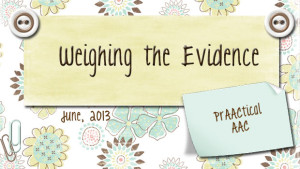
When people have significant communication difficulties that severely restrict their participation in daily life experiences, professionals and families alike sometimes find themselves attracted to the use of unproven methods. Although this usually comes from a good place, (i.e., the fervent desire to help someone), we have to be very careful in facing these decisions. Like you, we’ve heard comments like “Let’s try it. What’s the harm?” and they scare us. The harm can be difficult to quantify but is real nonetheless. Just talk to Gracie, whose mom cancelled therapies one summer and used the monies to take her swim with the dolphins. We’re not dolphin-haters, but there’s not much they can do for apraxia. We thought it was a good time to revisit this tutorial on differentiating science from pseudoscience. Many thanks to Dr. Caroline Bowen for hosting this article on her terrific website, Speech Language Therapy.com. Finn, P., Bothe,A.,... [Read More...]
Filed under: PrAACtical Thinking
Tagged With: best practices, EBP, evidence, pseudoscience, research, science
June 21, 2013
by Carole Zangari -

Though she was not the first of my clients with cerebral palsy who made me think long and hard about safety, Marla was the one who kept me up at night. It was the seventies, and I was a PCA when institutionalization was on the way out and community living was gaining ground. Marla lived on her own in an apartment and, for awhile when I was a college student, I visited her in the morning to get her up and at night to put her to bed. During the day, she could get around reasonably well and call for help if she needed it. But at night, after she was settled in bed, she was pretty much stuck there until someone returned in the morning. She didn’t have the physical skills to use a phone while lying down, and, if there was AT that would have helped, I... [Read More...]
Filed under: PrAACtical Thinking
Tagged With: communication boards, resources, safety, self-advocacy
June 20, 2013
by Carole Zangari -
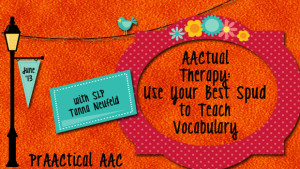
AACtual Therapist Tanna Neufeld comes through again, putting a prAACtical touch on an activity we all know and love. Tanna has generously shared both her ideas and the communication boards that she uses for this activity. You can download them in our eToolBox or go to the links at the end of this post. Tanna has great intervention tips (love her 80/20 idea!) that are prAACtical and effective for keeping kids engaged and learning. Mr. Potato Head is one of my favorite therapy tools for working with all kids, but especially beginning communicators. This awesome spud is not only a versatile toy-ripe for building, pretending, and interacting-but also a great tool for modeling vocabulary. For those little ones that you can keep engaged beyond the putting in and out of the building stage (tap into that good old fashioned, therapeutic use of self!), this toy really goes the distance. I... [Read More...]
Filed under: PrAACtical Thinking
Tagged With: AACtual therapy, commenting, communication book, download, Potato Head, resources, Tanna Neufeld, therapy activities
June 19, 2013
by Carole Zangari -
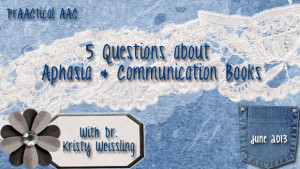
Today, we welcome back Dr. Kristy Weissling who shared some detailed thoughts on using AAC to support people with aphasia in this earlier post. In this post, she gets us thinking about what might be behind a situation familiar to many SLPs: Under-utilization of the AAC support/ :::::::::::::::::::::::::::::::::::::::::::::::::::::::::::::::::::::::::::::::::::::::::::::::::::::::::::::::::::::::: Five questions to ask yourself when the person with aphasia you are working with isn’t carrying their communication book. 1) How easy is it to take with them where they go? Is it convenient to use? 2) Does it contain messages they WANT to use? 3) Do they know how to find a message in the book when the time to use the book arises? 4) Have you practiced using the book with them? 5) Do they have another way to communicate the information in the book that they prefer to use? There are certainly many other possible questions to ask …..... [Read More...]
Filed under: PrAACtical Thinking
Tagged With: aphasia, communication book, portabilility, practice, self-reflection, vocabulary
June 18, 2013
by Robin Parker -
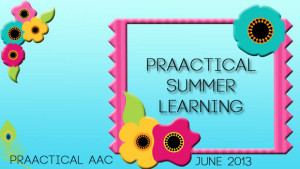
Summer is a great time for learning. Here are some awesome free webinars to check out. Accessible Instructional Materials from the National Center on Accessible Instructional Materials AbleNet Webinars: http://www.ablenetinc.com/emails/Newsletters_2013/AN-Univ-June2013.html
Filed under: PrAACtical Thinking
Tagged With: accessible materials, AIM, professional development, webinar
June 17, 2013
by Carole Zangari -
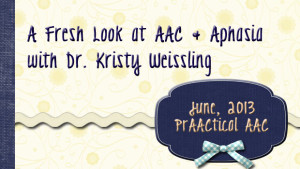
We’re so pleased to be able to share the thoughts of our friend and colleague, Dr. Kristy Weissling, on providing AAC supports to people with aphasia. She received her professional doctorate from Nova Southeastern University and is currently an Assistant Professor of Practice and clinical supervisor at the Barkley Speech-Language and Hearing Clinic at the University of Nebraska-Lincoln. Her research and teaching interests include, aphasia, cognitive communication impairments, and AAC. She participates in implementation of a portion of the RERC grant project at the University of Nebraska-Lincoln. She has been an instructor in aphasia and cognitive linguistic impairments for 15 years and teaches in both online and live formats. Her clinical load includes individual and group treatment of individuals with aphasia, traumatic brain injury, and early cognitive decline. In this post, Kristy reflects on three articles that have shaped her clinical services and teaching. :::::::::::::::::::::::::::::::::: I have been working with people who... [Read More...]
Filed under: PrAACtical Thinking
Tagged With: aphasia, EBP, Fresh Look, Kristy Weissling, research
June 14, 2013
by Robin Parker -
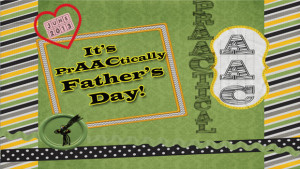
Some great free AAC resources for communicating with dad this Father’s Day and beyond: Talk to dad with visual conversational starters from Autism Teaching Strategies/Joel Shaul. Play a Mayor-Johnson symbol based memory game. Print, color, and create the game together and then have fun playing and communicating. Father’s Day Activity and Social Story (for those dads that like gardening) from Positively Autism For more ideas or inspiration about Father’s Day, see PrAACtical Reflections. Have a Great Father’s Day!
Filed under: PrAACtical Thinking
Tagged With: father's day, resources, Social Story
June 13, 2013
by Carole Zangari -
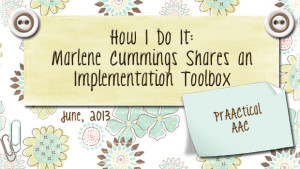
Now that the school year is winding down, some of you have a little more time to read, process, and prepare for next year. We are really excited to share more ideas from Marlene Cummings, one of the most experienced AAC SLPs that we know. Those of you who have been following Marlene’s posts on the AAC implementation will be pleased to see the next part of the Framework for Success that she developed with the AAC Team at Oakland School District. If you missed her first and second posts, go take a peek at them when you can. 5 Things in our “Implementation Toolbox” When we begin the process of implementing AAC it is important to consider our “thinking”. We always want to approach every student, every team and every classroom with as much wisdom and respect as possible. One of my colleagues, Dr. Penny Hatch, from UNC Chapel Hill... [Read More...]
Filed under: PrAACtical Thinking
Tagged With: AAC team, classroo, education, Marlene Cummings, schools, strategies
June 12, 2013
by Robin Parker -
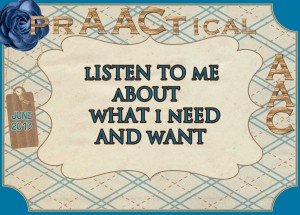
Some thoughts in poem form about communication, technology, and preferences. It humorously illustrates a high priority communication perspective. It was written as part of a learning challenge for a graduate course . It is reprinted with permission from the author Stacy Ganwer. Listen to Me AboutWhat I Need & Want by Stacy Gangwer Would you like my advice? On this device I use it to talk Even when I walk I use it everyday Even when I play I would like it to be small So I can still throw a ball This device needs to be tough Sometimes I’m rough on stuff It would be cool If I could use it by the pool I like things that are easy to learn So it doesn’t have to be returned I don’t have a ton of money So let’s not be funny If it could be cheap I won’t have... [Read More...]
Filed under: PrAACtical Thinking
Tagged With: ASD, assistive technology, autism spectrum disorders, communication
June 11, 2013
by Carole Zangari -
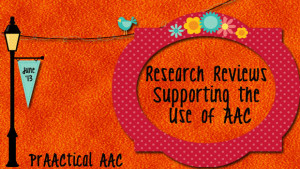
When recommending AAC, SLPs often find it useful to use research findings to support their clinical rationales. Sometimes we share articles with colleagues and families, or provide references in evaluation or consultation reports. In this post, we share a number of research reviews, studies which examined previously done research in AAC. Finding a relevant systematic is like hitting the jackpot, because the researchers have already done an exhaustive search of the literature on the topic, then analyzed the studies that met their criteria. Here are several research reviews that might come in handy during your AAC work. Ganz, J.B., Earles-Vollrath, T.L., Heath, A.K., Parker, R.I., Rispoli, M.J., & Duran, J.B. (2012). A meta-analysis of single case research studies on aided augmentative and alternative communication systems with individuals with autism spectrum disorders. Journal of Autism and Developmental Disorders, 42,1, 60-74. McCarthy, J., & Light, J. (2005). Attitudes toward individuals who use... [Read More...]
Filed under: PrAACtical Thinking
Tagged With: EBP, reference list, research, systematic review









